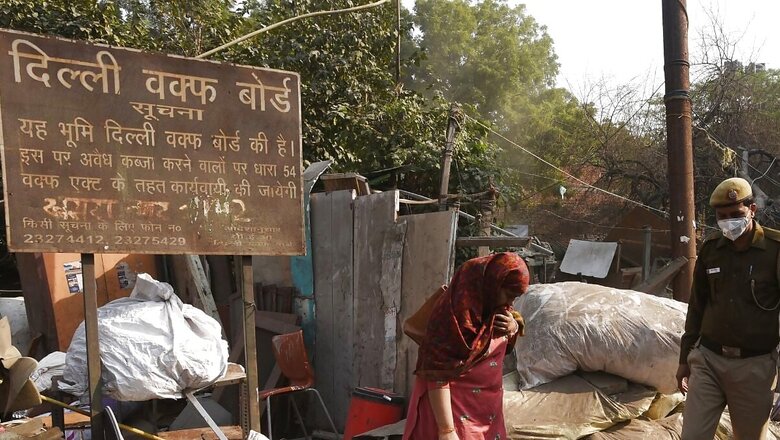
views
The concept of Waqf may have been introduced in India during the Delhi Sultanate and flourished during Firoz Shah Tughlaq’s rule, but its all-encompassing powers came after India’s Independence through various laws passed in Parliament.
It was in 2013, just a year before Narendra Modi swept to power, that the UPA government — through the Waqf (Amendment) Act, 2013 — gave expansive powers to the Waqf Board.
With the Modi government all set to bring amendments to the Act to curtail the board’s powers, very few would know that India’s Waqf laws failed to modernise with the times compared to Muslim nations like Turkey, Syria, Oman, Iraq or UAE. Sources suggest the government studied the laws pertaining to Waqf in the Muslim nations before deciding to go ahead and make the boards in India more centralised, modern and transparent — a move that made India’s top Muslim clerics throw their weight behind the government’s idea.
The Waqf Act, 1995, confers excessive powers with respect to the applicability of the Act. The Waqf definition has been enlarged and suo moto powers of the land survey have been given to the Waqf board. Such a scenario does not prevail in Waqf Acts in other Muslim nations.
TURKEY
Take Turkey, for instance, where the Waqf system has deep roots in the Ottoman Empire. In Turkey, the Waqfs played a crucial role in social welfare, education, and infrastructure. But, soon after the establishment of the Turkish Republic in 1923, the Ministry of Waqfs was abolished in 1924. Waqf properties were taken over by the General Directorate of Foundations. This centralisation aimed to modernise and secularise the administration of Waqfs.
Today, the General Directorate oversees the management, restoration, and utilisation of Waqf properties. It also ensures that Waqf revenues are used for public-welfare projects. Turkey’s Waqf system underwent significant reforms to align with secular principles, whereas India’s system operates within a framework that balances religious and legal considerations.
KUWAIT
Even in Kuwait, where historically Waqfs have played a significant role in supporting religious, educational, and social services, the administration of Waqf properties is overseen by the Ministry of Awqaf and Islamic Affairs. The ministry focuses on the development and maintenance of Waqf properties, including mosques, schools, and hospitals. In an attempt to make it relevant even in 2024, it also works on modernising Waqf management through digitisation and improving transparency and efficiency — a far cry from India’s Waqf system.
LEBANON
Even Lebanon, which has been engaged in a war with Israel due to the presence of Hezbollah militants in its southern part, can boast of a more centralised and modern Waqf system than India.
The governance of Waqf properties has evolved through various legal reforms, particularly during the Ottoman period and the French Mandate. As a result, it now operates under the Ministry of Endowments and Islamic Affairs. This body is responsible for managing Waqf properties, ensuring their proper use, and overseeing the distribution of Waqf revenues for charitable purposes. Like Kuwait, efforts are being made to modernise Waqf management through digitisation and improving transparency and efficiency.
SYRIA
Waqf properties in Syria are overseen by the Ministry of Awqaf which ensures the proper use of Waqf properties as well as overseeing the distribution of Waqf revenues for charitable purposes. Syria’s Waqf administration is centralised under the Ministry of Awqaf, while India’s system is more decentralised, with state Waqf boards playing a significant role.
IRAQ
In Iraq, Waqf is managed by the Sunni Endowment Office and the Shiite Endowment Office, established after the fall of Saddam Hussein in 2003. They have a centralised administration with separate offices for Sunni and Shiite endowments. Iraq’s Waqf administration is divided along sectarian lines (Sunni and Shiite), whereas India’s Waqf Boards manage properties without such a division.
SAUDI ARABIA
If you turn to the land of Mecca, the Waqf management has also evolved with time. In Saudi Arabia, it is managed by the General Authority for Awqaf (GAA), established by Royal Decree in 2016. The GAA is a public body with financial and administrative independence but linked directly to the prime minister. Saudi Arabia focused more on modernising Waqf management and integrating it into national development, whereas India faces more traditional challenges like political interference and governance issues.
The comparisons can go on with Middle Eastern nations like the United Arab Emirates and Oman or South Asian nations like Singapore and Indonesia. The only attempt to modernise India’s Waqf system was made in 1984 when the recommendations of the Waqf Inquiry Committee were turned into the Waqf (Amendment) Act, 1984. It provided for the reconstitution of Waqf Boards with elaborate additional powers, the constitution of Waqf Tribunals, the appointment of several committees and appointments as well as enlarged powers of the Waqf commissioners among others. However, stiff opposition and political realities did not let the modernisation become a reality.
Now, with the backing of top Muslim clerics who have called India’s Waqf system “discriminatory”, the Narendra Modi government has a chance to do what the then government failed in 1984.
Catch the latest developments on Bangladesh Unrest with our live blog.


















Comments
0 comment